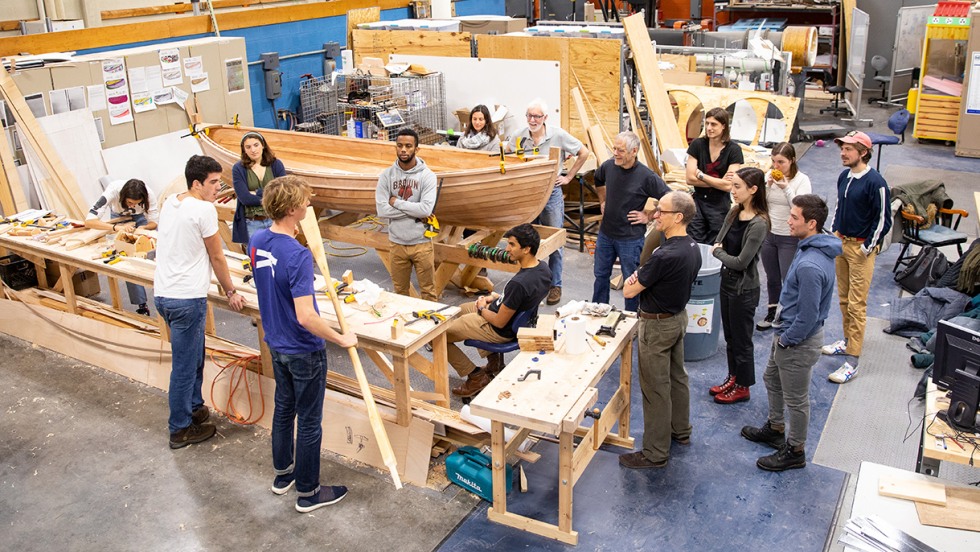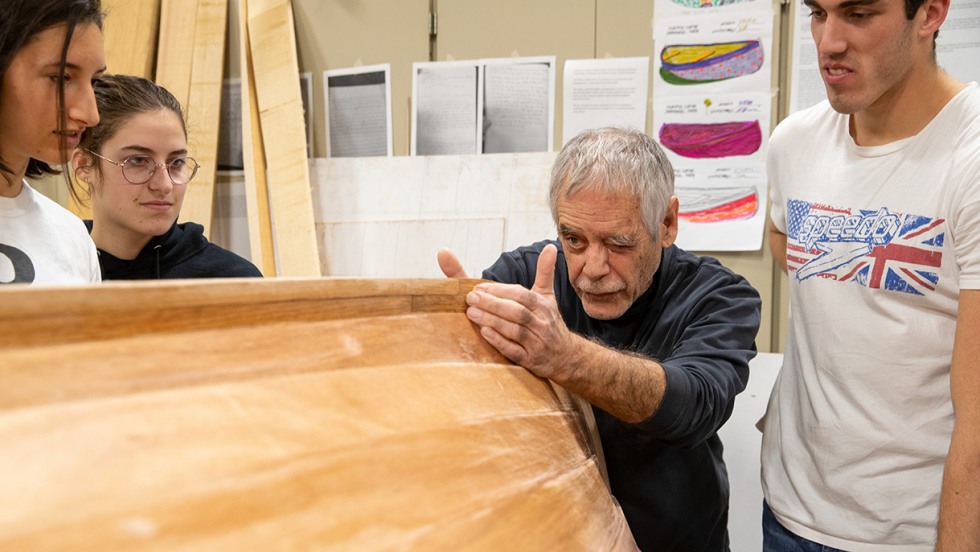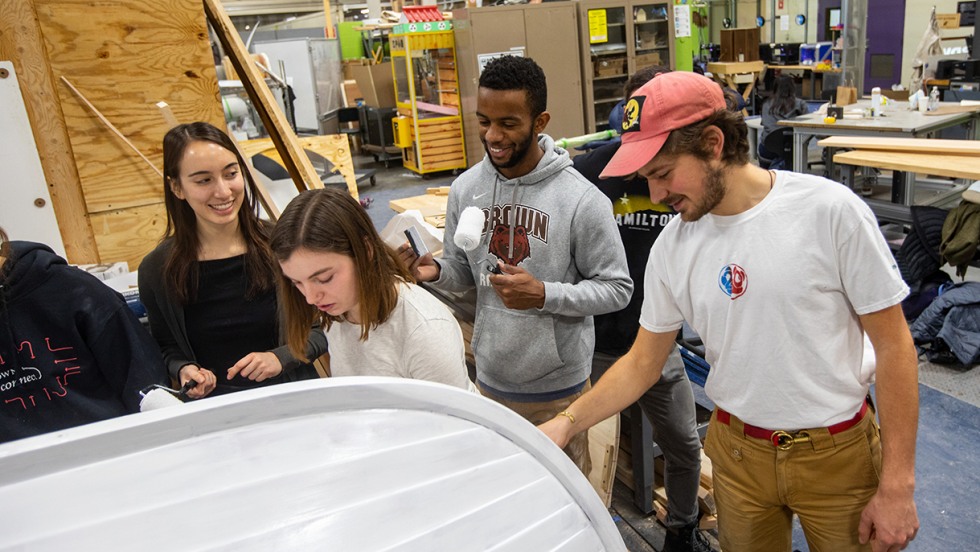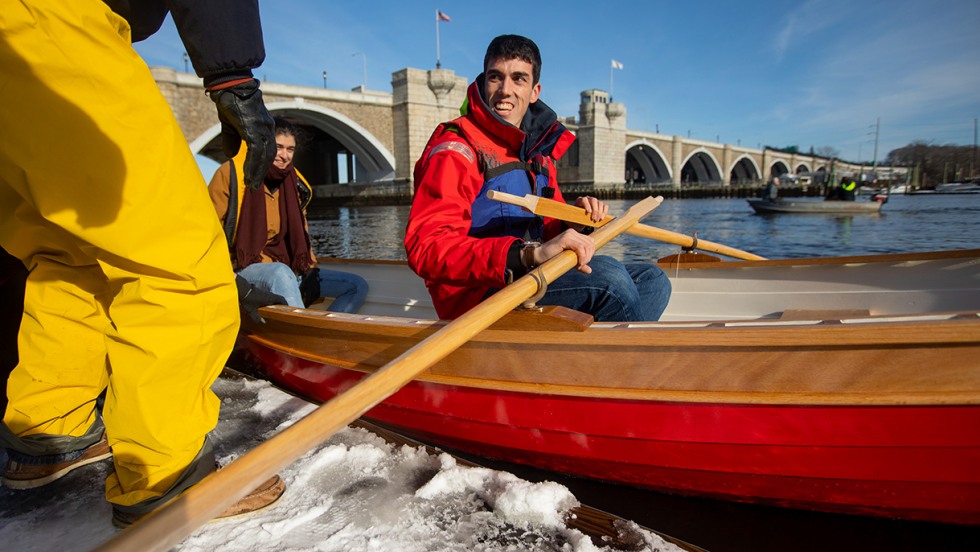Boatbuilding Course at Brown Includes Equal Parts Discussion and Construction
In "Boatbuilding: Design, Making and Culture," at once a humanities seminar and a hands-on engineering lesson, students from concentrations across the University built and launched a wooden boat.




As a child in the former Yugoslavia, Mara Jovanović took up the art of wood carving with only an axe and some small knives as tools.
"I used my granddad's shed to make simple things — mostly chess pieces," said Jovanović, a sophomore at Brown. "I could only dream of a fully stocked design workshop."
When the architecture concentrator arrived at Brown, she discovered the Brown Design Workshop — a student-operated "makerspace" that soon became her home away from home. There, she has created woodworking projects and paintings, done carpentry work for student theater productions, and worked as a monitor, helping newcomers navigate the collaborative workspace and making them feel welcome.
The fall 2019 semester brought her most exciting Brown Design Workshop project to date: the conception and construction of a boat.
Between September and December, Jovanović and 16 other students in the American studies and engineering course "Boatbuilding: Design, Making and Culture" spent countless hours in the workshop sawing, gluing, carving and priming a Maine peapod — a wooden vessel commonly used by New England fishermen in the 1800s. Equal parts cultural seminar and hands-on lesson, the course saw students devote as much time reading about and discussing the history of skilled labor, material culture and the nature of technological design as they did consulting plans and constructing the boat.
Following weeks of labor, students and faculty involved in the course came together on Wednesday, Dec. 12, for the maiden voyage of the finished peapod, launching it for the first time into the Seekonk River.
Steven Lubar, a professor of American studies and history, said the idea for the course came when he found out that Gerald "Shep" Shapiro, a professor emeritus of music at Brown, had become a boatbuilder. A grant from the Brown Arts Initiative created an artist-in-residence position for Shapiro to help teach the course.
"I was teaching a first-year seminar called 'Skill,' which is all about the history and cultural aspect of skilled labor," Lubar said. "Then I met with Shep and we thought, why can't this become something more hands-on? Shep's design, boatbuilding and teaching skills made the course possible."
The course met twice a week — once for discussion, headed by Lubar, and again for construction, led by Shapiro and Christopher Bull, a senior lecturer in engineering and director of the Brown Design Workshop. To prepare for the weekly discussions, students read a wide-ranging mix of building instruction manuals, design histories, papers from social science journals and essays on the intersection of physical work and cultural tradition.
How you teach engineering is endlessly debatable. Is it about calculus? Is it about design? Is it about society? All of these things are interesting facets of engineering.
Construction days began modestly, with students learning how to interpret design drawings and calculate curves, constructing their own small models and building a workbench. Some undergraduates in the course had never held a saw before September. Others with more building experience, including Jovanović and fellow teaching assistant Geoffrey Hazard, took responsibility for specific elements for the boat: Jovanović tasked herself with constructing one of the seats, and a pair of students on Brown's crew team committed to crafting the oars.
"It's a back-and-forth between making things and thinking about the process of making itself," Lubar said. "Sometimes we'll be discussing the nature of using a hammer, the single-minded focus it requires, what that suggests about how the brain works — and then we say, 'You know what? Let's go out and try this.' And we leave the philosophical thinking behind for a moment and just use a hammer. That's the way the class works best."
The basis for the boat design, Jovanović said, was a set of measurements from an actual 1800s boat — essentially a table of numbers that translates to a particular set of angles and curves. But students learned that the plans were merely a suggestion, both to 19th-century craftsmen and present-day builders. As students clamped each piece of wood into the plan's prescribed shape, they stepped back to assess whether the wood created a "fair curve."
"Those numbers describe a shape, but it's up to you to decide whether that shape is pleasing to you," Jovanović said. "The idea of a 'fair curve' is the idea that, if I decide the numbers don't make a pretty shape, I have the authority to override that."
The idea of a "fair curve," the subject of much discussion during the course, perfectly illustrates that engineering isn't a purely technical profession, Bull said.
"How you teach engineering is endlessly debatable," Bull said. "Is it about calculus? Is it about design? Is it about society? All of these things are interesting facets of engineering."
"What I'd love students to get from this class is that building is both practical and personal," Lubar said. "They have to think not only about how this boat will behave in water but also what, to them and to the boatbuilders and users of the 19th century, makes a good boat, a beautiful boat. With any project — in any profession, really — there's materials and skills and processes… and then there's what you want to do. You can't separate one from the other."
Lubar said plans are coming together for a Spring 2020 exhibition of the finished boat at the Granoff Center for the Creative Arts.
Videos by Stephen Crocker/Brown University